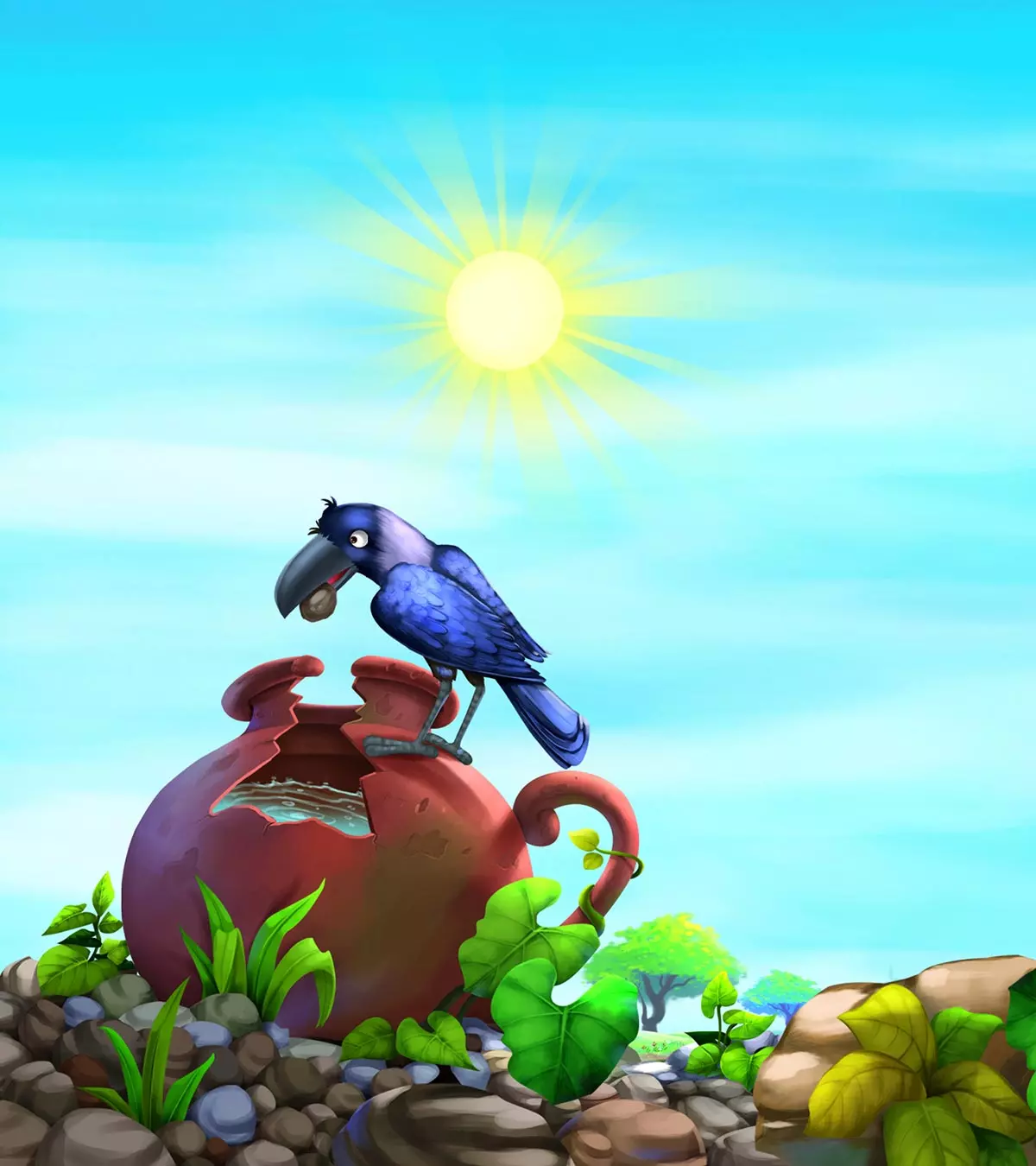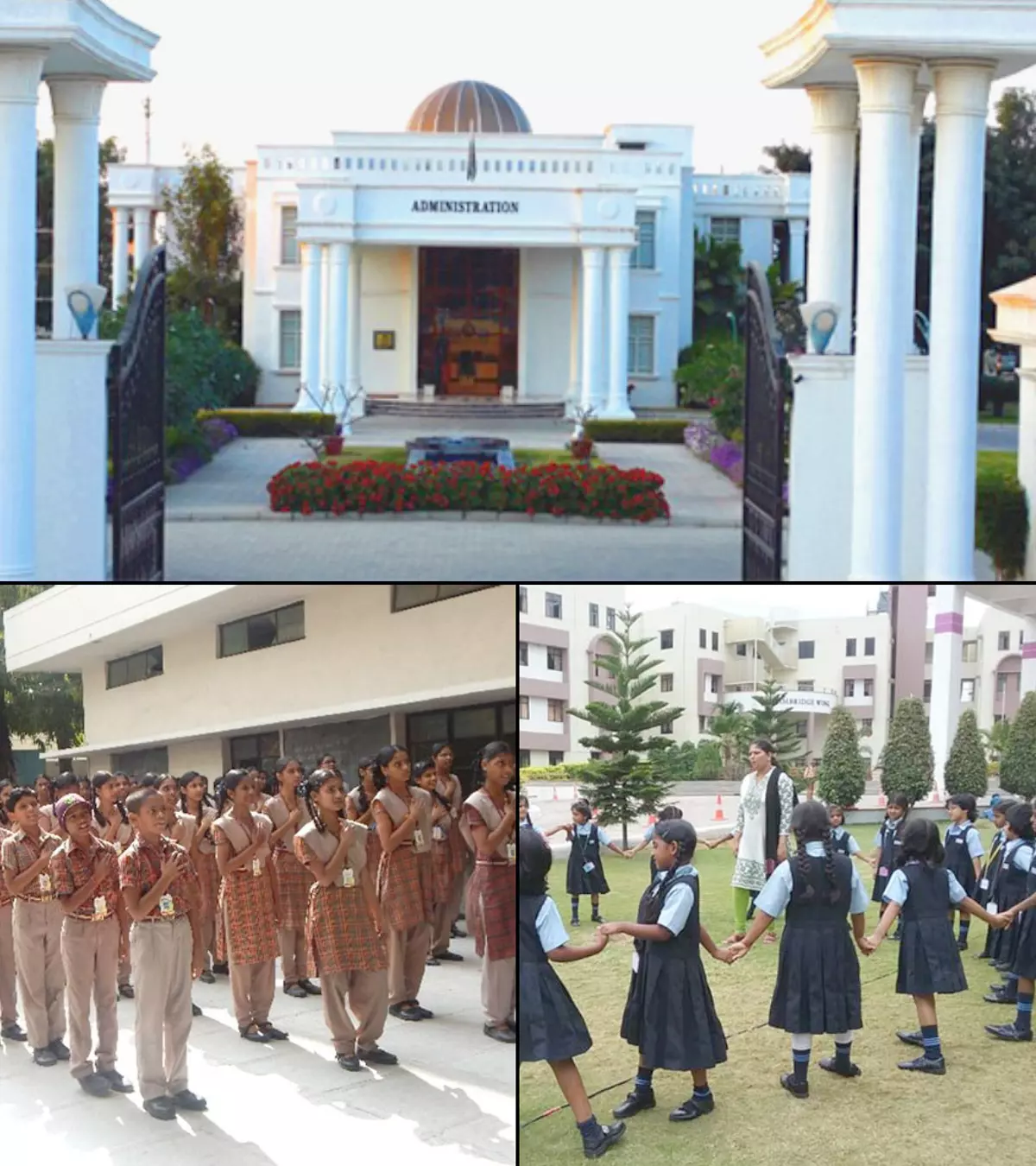
Image: Midjourney/ MomJunction Design Team
Lord Shiva stories for kids are quite intriguing. Also known as Mahadev, he is one of the three deities of the ‘Great Trinity’ or ‘The Hindu Triad’, as per Hinduism. The three gods Brahma, Vishnu, and Shiva are responsible for the creation, maintenance, and destruction of the universe respectively.
Shiva is considered very powerful yet soft-hearted, one who melts like ice to the prayers of His devotees. Over the centuries, numerous temples have been erected for him and a number of stories have been written and read about Lord Shiva’s powers, love, anger, and more.
Stories about him are entertaining and impart valuable lessons about love, devotion, and moral values, making them ideal for young minds. Here are some of the most popular legends of Lord Shiva you can tell your kids.
Key Pointers
- Lord Shiva’s stories are culturally significant and give a glimpse of Indian mythology.
- The stories convey values of compassion, kindness, and devotion to children.
- Parents can read these stories and create fun bonding moments with their children.
- The lessons learned from these stories could be helpful to the child as they grow older.
10 Interesting Lord Shiva Stories For Kids
1. The birth of Lord Shiva

Shiva is also referred to as Swayambhu (meaning ‘self-existing’) because he was not born from the womb of a woman. There is an interesting story behind the birth of Lord Shiva.
One day, Brahma and Vishnu were arguing about each other’s predominance and importance in the universe. As the debate was on, a mysterious pillar appeared in front of them. Both of them could not understand what the pillar was and wondered if there exists any other supreme power than them.
They decided to unravel the mystery of the mighty pillar. Lord Brahma transformed into a goose and flew upward to find the apex of the pillar while Lord Vishnu transformed into a boar and dug the ground to find the root.
However, they could find neither and came back to the place from where they started only to witness the emergence of Lord Shiva from the pillar. It made them accept the fact that Lord Shiva was the supreme power. It is one of the best stories of Lord Shiva.
2. Marriage of Shiva and Parvati
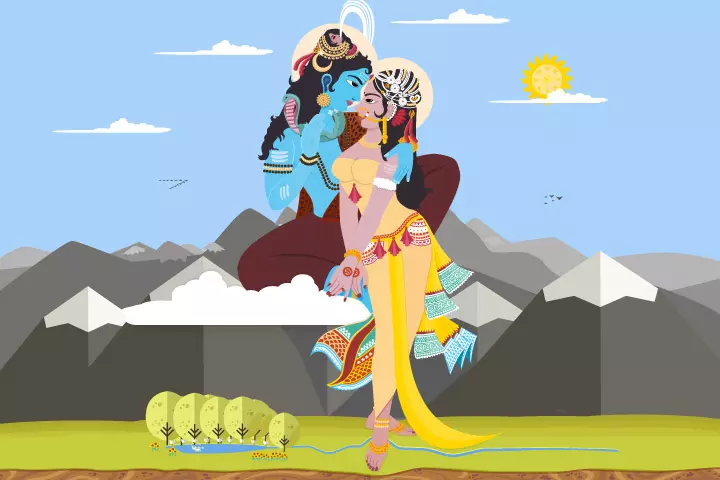
It is a story of divine love. The reincarnationiA belief that a deceased person's spirit will take abode in a new body of goddess Gauridevi as Parvati and her strong desire to marry Lord Shiva is an example of eternal love.
The ruler of Himalaya, Himavatha, and his wife Menaka were ardent followers of Lord Shiva and wished for a daughter who could marry the deity. For this, Menaka performs a three-day long penanceiAn act that demonstrates that you are sorry or regretful about something that you have done to appease goddess Gauridevi, the first wife of Lord Shiva. The goddess promises Menaka to take birth as their daughter. She jumps into the fire to be reincarnated as Parvati. This leaves Shiva heart-broken and he goes into a long penance to mourn the loss of his beloved wife.
One day, sage Narada visits the kingdom of Himavatha to see the baby and predicts that she will marry Lord Shiva. As Parvati grows, she spends day and night praying for Shiva.
Appeased by Parvati’s devotion, Shiva decides to test her by disguising himself as a Brahmin. He tells her not to marry a person who is poor and devoid of a materialistic life. However, Parvati says firmly, “I would marry none other than Shiva.”
The pleasing answer makes Shiva come back to his original form and acknowledge the marriage proposal. Thus he gets back his wife in the form of Parvati. The story of their marriage is one of the most famous stories of Shiva.
3. Lord Shiva and the fisherwoman
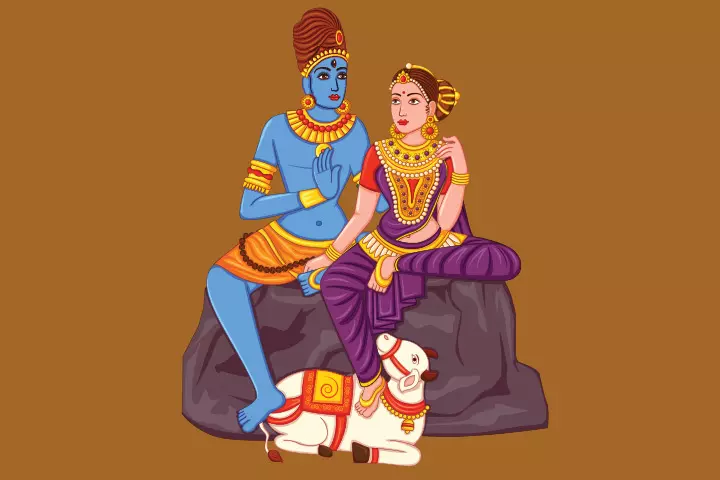
Lord Shiva starts explaining the Vedas to his wife Parvati, and that goes on for several years. But one day, Parvati loses her concentration. The annoyed Shiva curses her to go to the earth and take birth as a fisherwoman.
Parvati takes birth as a baby girl and the chief of the fishermen community, Parvaras, takes her to his home. He names her Parvati and brings her up.
Meanwhile, Shiva realizes his mistake and starts missing his wife. Seeing this, his disciple Nandi suggests Shiva call Parvati back. Shiva replies that he can’t do it because as per her birth, she is destined to marry an angleriA person who enjoys fishing using a fishing rod, a hook, and a line in their spare time .
Hearing this, Nandi comes up with a plan to reunite Shiva and Parvati. He takes the form of a big shark and goes into the sea where the fishermen go fishing. He starts troubling the fishermen. Knowing about it, Parvaras announces that whoever catches the whale would get to marry his daughter.
The chief and his daughter Parvati pray to Lord Shiva to help them. Listening to Parvati’s prayers, Lord Shiva turns into a young fisherman and comes to the fishermen’s rescue. Nandi happily lets his master catch him. This way, in the story, Shiva remarries Parvati.
4. Birth of Lord Shiva’s daughter, Ashoka Sundari
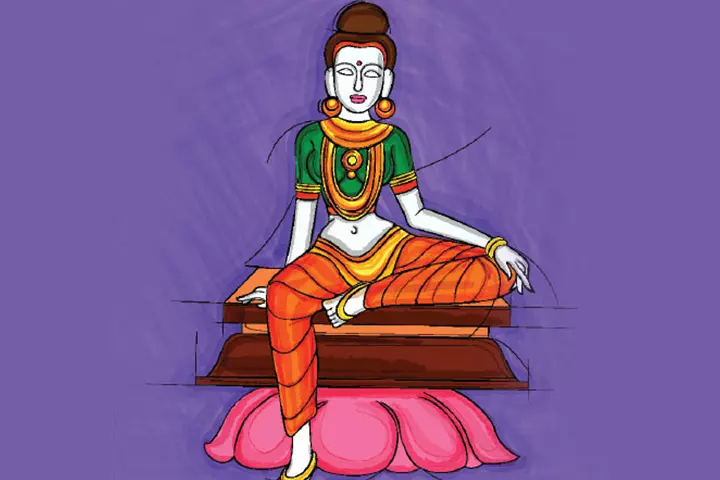
Lord Shiva and Goddess Parvati were taking a stroll in the beautiful garden Nandanavana when they come across the wish-fulfilling tree Kalpavriksha. Parvati often used to feel lonely when Shiva would go out of the Kailash mountain to fight the evil forces. So, she wishes for a daughter from the Kalpavriksha and the wish gets granted.
A daughter is born to Parvati, whom she names as Ashoka Sundari, wherein Ashoka means ‘without sorrow’ and Sundari means ‘beautiful’. Folklore goes that when Shiva beheaded Lord Ganesha, Ashoka Sundari was present there. As she got scared by her father’s act, she hid behind a sack of salt. Later, her father pacifies her and brings her back to normal. Thus, Ashoka Sundari’s name got associated with salt.
5. Lord Shiva and Bhasmasura

In the Himalayas, there was a rakshasaiIndian mythical goblin or demon named Bhasmasura, who spent years in meditation to please Lord Shiva. Appeased by his devotion, Shiva appears before him and asks him to make a wish.
The clever Bhasmasura asks, “Lord, grant me the boon that whatever I touch with my right hand will turn into ashes immediately.” Shiva grants the boon not realizing the evil intentions of the rakshasa.
Bhasmasura intends to test the boon on the lord himself, to turn Shiva into ash and gain the supreme power. Even as he chases Shiva, Lord Vishnu witnesses this and decides to save Shiva from the rakshasa.
Vishnu turns into a beautiful woman named Mohini and appears before Bhasmasura. Her mesmerizing beauty makes him fall for her and propose to her. Mohini tells him that she would marry him if he can dance like her and defeat her.
Bhasmasura agrees and follows every step of Mohini with élaniA combination of gracefulness with enthusiasm . As his confidence keeps increasing, Mohini does a step by putting her right hand on her head. The overconfident rakshasa forgets about his boon and puts his right hand on his head. Immediately, he turns into ash.
Lord Shiva is also known as Nataraja, which is Sanskrit for ‘Lord of the Dance.’ In this form, he is portrayed as the cosmic dancer and represented in metal or stone.
6. Lord Shiva and the halahala poison

Do you know how Lord Shiva got the name ‘Neelkanth’? This is one of the fascinating mythological stories for kids.
Sage Durvasa once cursed all the gods, leaving them powerless and depriving them of all their fortunes. The gods seek help from Lord Vishnu, who suggests they should churn the ocean to retrieve nectar that can help them become immortal and bring back the lost fortunes.
The gods partner with the demons to combine their strengths for churning the ocean. Vasuki, the serpent, is made the churning rope and mount Mandara as the churning rod. During the churning process, many things come out of the ocean including the halahala poison, which had the capability to wipe out the entire creation in the universe.
Terrified with the spread of the poison, all the gods approach Lord Vishnu again. He directs them to Lord Shiva, as he is the only one who can protect them. Lord Shiva offers to drink the poison but squeezes his throat tight to prevent the poison from entering the body.
The poison turns Shiva’s throat blue and hence he is also called Neelkanth, wherein neel means ‘blue’ and kanth means ‘throat’.
7. The story of Sudarshana Chakra
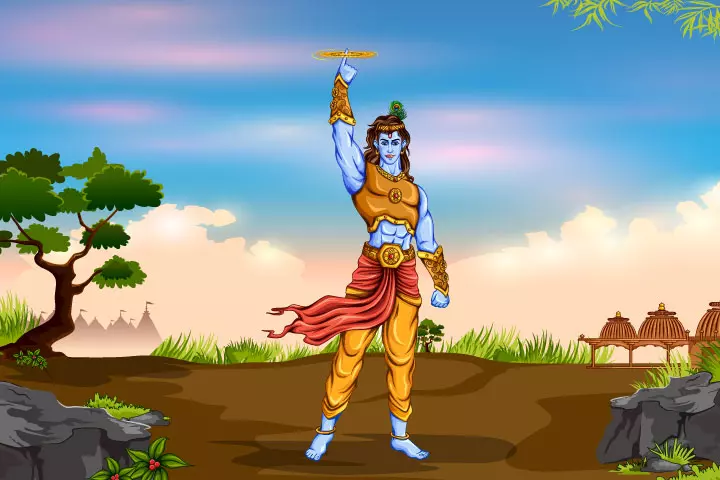
One day, all gods approach Lord Vishnu pleading with him to save them from the attack of the rakshasas. Lord Vishnu says that he does not have enough power to fight the demons and would have to seek Lord Shiva’s help. When he reaches Kailash, he finds Lord Shiva in a deep trance. Unwilling to disturb him, Lord Vishnu decides to pray for Shiva until he comes out of his trance.
Vishnu would chant the name of Shiva a thousand times every day by offering one lotus flower against each chant. This goes on for many years before Shiva comes out of the trance one day. Not knowing that Shiva has come out of his trance, Vishnu continues his chanting for the day.
Shiva decides to play a trick on Vishnu, and secretly removes one lotus from the bunch that Vishnu had arranged. After Vishnu chants for 999 times, he realizes that one flower is missing from his collection. He immediately plucks out his eye and offers it at the feet of Shiva.
Impressed by Vishnu’s devotion, Shiva tells him to ask for a boon. Vishnu asks him to give the power to defeat the demons to save all the gods. Lord Shiva gives him a round disc, called the ‘Sudarshana Chakra’, which has the power to kill anything.
8. Ravana shakes mount Kailash

Ravana is a great devotee of Lord Shiva. But one day he tries to pull down the abode of Lord Shiva, the mount Kailash. Though he fails in his attempt, this act angers Shiva and he traps Ravana below the mount Kailash.
Then, Ravana starts singing songs in praise of Shiva. He cuts one of his heads to make a veena (an Indian musical instrument) and uses the tendons as strings to play music. This goes on for several years before Shiva is impressed. He forgives Ravana and sets him free.
9. Lord Shiva’s third eye

Lord Shiva is also called ‘Trilochan’ as he has three eyes. There is an interesting story behind the third eye of Lord Shiva.
One day when Shiva was meditating, his consort, Parvati thought of playing a game with him. She came from behind and closed his eyes with both her hands. It is believed that the right eye of Shiva represents the sun and the left eye represents the moon.
Closing his eyes led to chaos everywhere as the universe sunk into darkness. Immediately, Shiva created the third eye on his forehead with his divine powers to emit fire. Also, the heat from the fire caused Parvati’s hands to perspire. The sweat, combined with the powers of both Lord Shiva and Goddess Parvati, transformed into their child named Andhaka.
10. River Ganga flows from Lord Shiva’s head
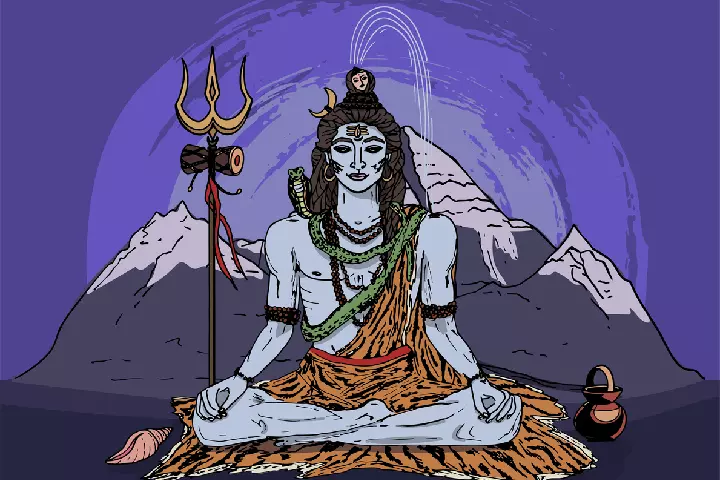
Lord Shiva is also known as ‘Jatadhara’ because he has matted hair, from which the holy river Ganga flows. The story behind this is as follows:
King Sagar was a powerful ruler of Suryavansha dynasty. One day, he decided to conduct the Ashwamedha Yagya, which would help him maintain his sovereignty. For this, he prepared a horse that would wander for a year. However, the God of rains and storms, Indra, felt jealous of the king and hid the horse in Sage Kapil’s ashram. King Sagara sent his sons to look for the horse, who found it in Sage Kapil’s ashram. Sage Kapil was in deep meditation when King Sagar’s sons started assaulting him. Angry, the Sage burned all the 60,000 sons of the king.
King Sagar then sent his grandson to the Sage, asking him for a way to help the souls of his son’s achieve deliverance. Sage Kapil said that only the water of the Holy River Ganga can help purify their souls. However, the divine river only flowed in the heavens. So, Anshuman prayed to Lord Brahma to allow the river to descend on earth. However, the earth was not equipped to withstand the holy power of the divine river, and it could cause tremendous damage to nature and humans. Hence, Lord Shiva took the river on his head to protect the world from destruction and allowed it to flow gently through the majestic Himalayas.
Frequently Asked Questions
1. Why did Shiva turn blue?
Shiva consumed a lethal poison called Halahal to save the universe, which turned his body blue. However, he managed to hold it in his throat without letting it go into his body, and his neck turned blue. This is why he is also known as ‘Neelkanta’ (the one with a blue neck).
2. How many daughters do Shiva and Parvati have?
Ashoka Sundari, Manasa, and Jyoti are the three daughters of Lord Shiva and Goddess Parvati. These daughters have been mentioned in Shiva Purana and are still worshiped in some parts of India.
3. Who is the real son of Lord Shiva?
According to Shiva Purana, Lord Kartikeya is the first son of Shiva and Parvathi. Lord Shiva also has two other sons, Lord Ganesha and Lord Ayyappa.
4. What can children learn from the stories of Lord Shiva?
Stories about Lord Shiva teach important moral values such as courage, kindness, and humility. These tales also help children understand the significance of devotion and familiarize them with the incredible adventures of a beloved deity. These lessons can inspire them to lead a life of purpose and respect for others.
Lord Shiva is the universe’s creator, protector, and transformer, according to the Hindu mythology. His powerful persona and divinity give his followers an understanding of fundamental life facts that help them live a happy and contented life. Reading these interesting Lord Shiva stories for kids is a great way to acquaint your child with this powerful deity. Indian mythological stories for kids, including those about Lord Shiva, can be read aloud or enjoyed independently while you explain the deeper meanings hidden within the narratives. You can read these stories to your child or let them read while you explain the deep meaning hidden behind the narrative. Either way, these stories will help your child know about Lord Shiva and help them lead a life of purpose.
Illustration: Interesting Lord Shiva Stories For Kids

Image: Stable Diffusion/MomJunction Design Team
Experience the magical love story of Shiva and Parvati, the divine couple of Indian mythology. Watch as their love blossoms and their bond strengthens over time.
Community Experiences
Join the conversation and become a part of our nurturing community! Share your stories, experiences, and insights to connect with fellow parents.
Read full bio of Visti Larsen
Read full bio of Harshita Makvana
Read full bio of Deepa Thomas




